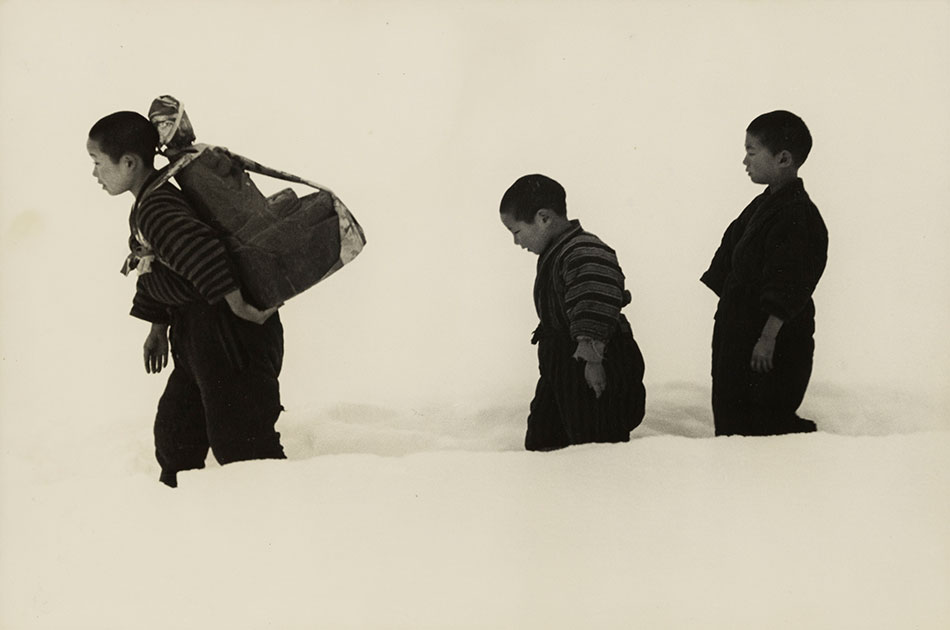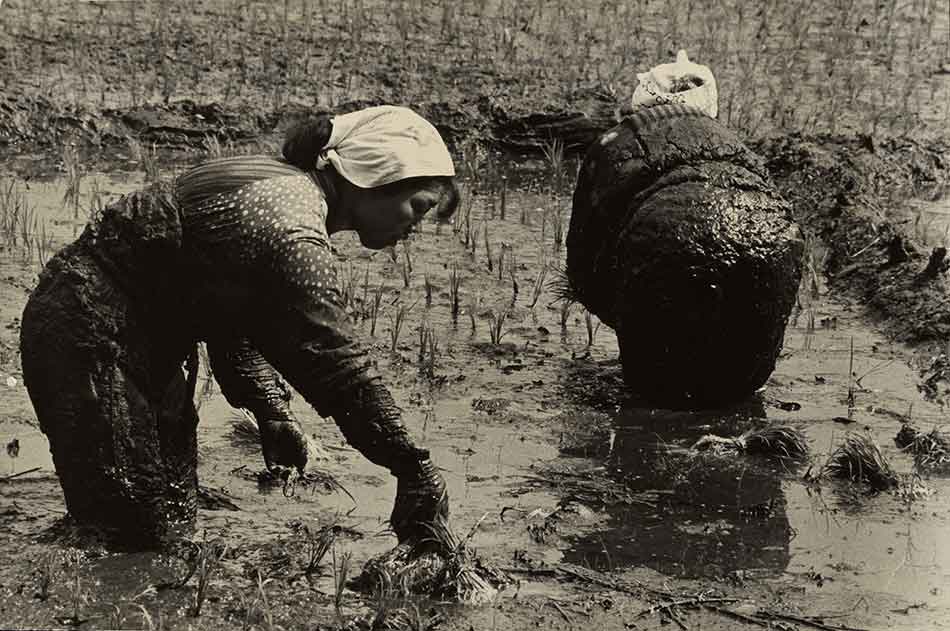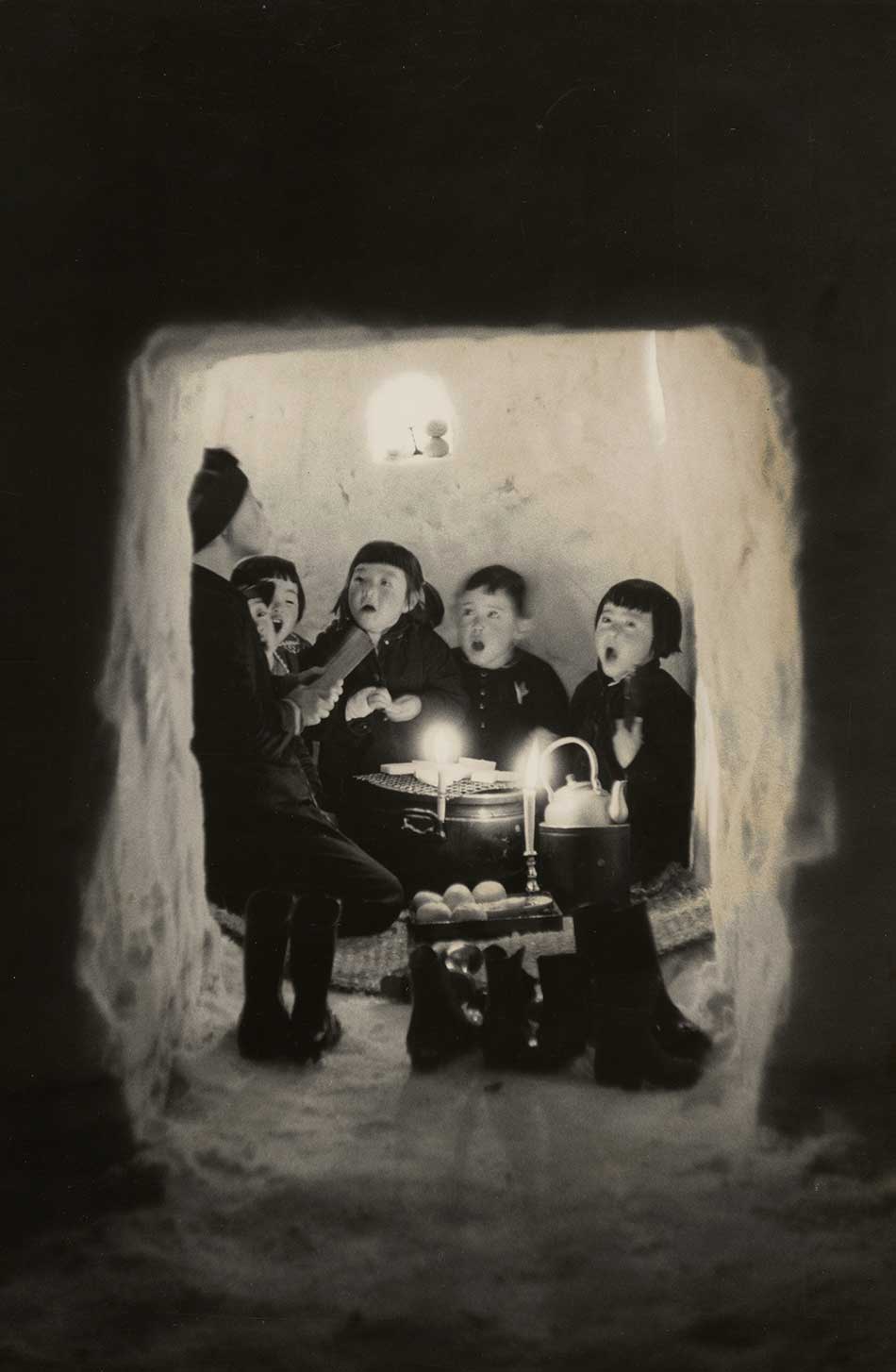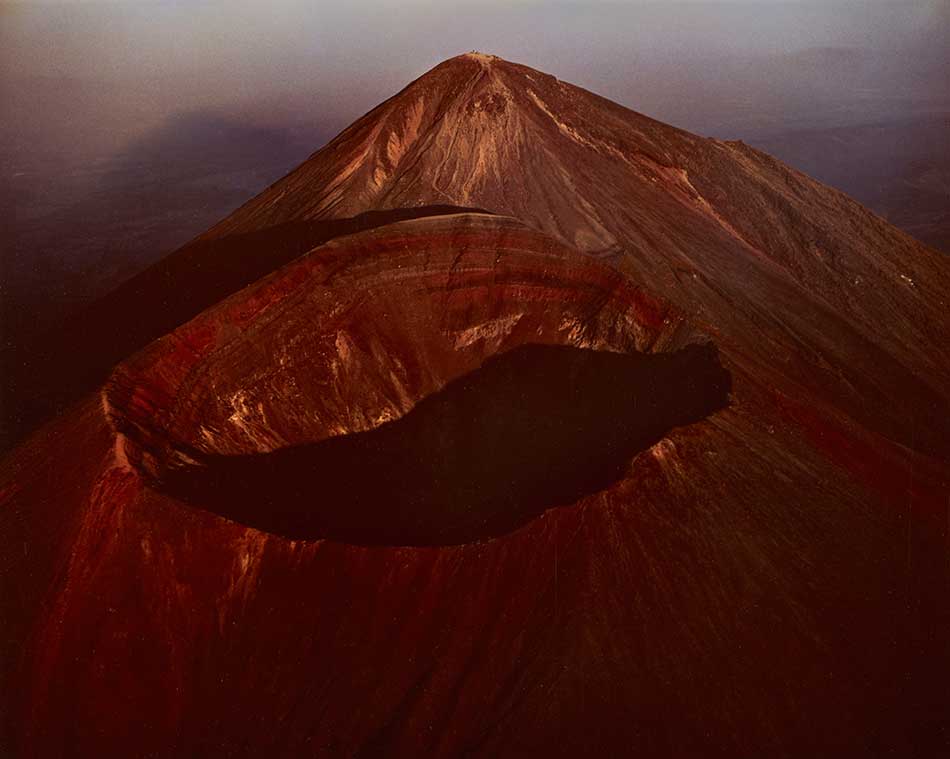The Japanese photographer Hiroshi Hamaya took many kinds of pictures, from Tokyo bargirls to smoking volcanoes. I knew him a bit in the 1970s when he was in his early sixties, an elegant kimonoed figure with hawkish features and shoulder-length grey hair, living with his wife in a beautiful wooden house south of Tokyo. He was a kind of hippy traditionalist, bohemian and deeply attached to the Japanese past. He had designed his house himself, entirely in accordance with traditional Japanese craftsmanship.
As “Japan’s Modern Divide,” a new exhibition at the J. Paul Getty Museum suggests, Hamaya’s distinctive documentary photographs can be usefully contrasted with his compatriot Kansuke Yamamoto’s modernist photographic collages. Like Yamamoto, Hamaya had been interested as a young photographer in the 1930s in avant garde movements that came from Europe—Surrealism, Bauhaus, and so forth. Yamamoto remained a surrealist when Japanese culture became ever more nationalistic in the late 1930s. After the attack on Pearl Harbor, Surrealism would be banned as insufficiently patriotic. But Hamaya had turned away from geijutsu shashin (“art photography”) by then and embarked on his extraordinary documentation of rural life in the northeast of Japan, the so-called Snow Country—poor, freezing in winter, deeply traditional. So while Yamamoto continued to be inspired by the works of Man Ray and Moholy Nagy until the authorities stepped in, Hamaya, as it were, planted himself into the native Japanese soil. It is for these rural pictures—black and white, beautifully printed, of rice farmers working to their waists in muddy rice paddies, of villagers celebrating “fire festivals” and other ceremonial occasions, of public baths, blind musicians, and the worship of Shinto deities—that he is best known.
This was not his natural milieu. Hamaya was born in a plebeian district of Tokyo, and his early photographs of the 1930s are of its typical denizens: geisha, beggars, prostitutes, and burlesque dancers. Typical urban scenes, in other words. His rejection of this world for the primitive life of peasants in the Snow Country is an interesting example of how important art can emerge from questionable motives.
I once heard a lecture by a distinguished young Polish art historian about something called Ostforschung, literally scholarship of the east, that is, of European arts and crafts east of Germany. This type of research, current during the Third Reich, took a racial view of art history. German scholars set off for Poland and other parts of eastern Europe in search of Germanic roots, the essence of the Teutonic “Geist.” Under the Nazi occupation of Poland, this logic would be used to justify German looting of Polish churches and museum collections, in the guise of “repatriating” art that expressed the spirit of the German Volk.
The point of the Polish art historian’s lecture was that everything about Ostforschung was in bad faith, and so all its conclusions had to be bogus. Some young German art historians in the audience, all impeccably liberal-minded academics, questioned this view. Wouldn’t it be possible, they wondered, that interesting answers could still come from questions asked for the wrong reasons?
Hiroshi Hamaya got swept away in the 1940s by a Japanese version, not exactly of Ostforschung, but of chauvinistic ethnography. Especially after the Pacific War with Western powers began in 1941, Japanese nationalists became rather obsessed by Yamato-damashii, the “Japanese spirit,” by the uniqueness of the Japanese race, and the deep authenticity of rural traditional life compared to the shallow, decadent, and above all “Westernized” life of the major Japanese cities.
Conferences were held at Japanese universities, where learned scholars discussed how to “overcome modernity,” by which they meant modern Western influences, such as Marxism or liberal thinking, Hollywood entertainment, popular music, avant garde art, and high fashion—many of the things, in short, that had fascinated the young Hiroshi Hamaya. After all, Hamaya had once been a typical “mobo,” short for modern boy, also sometimes known as “Marx boy.”
In 1942, a year after Pearl Harbor, Hamaya was working for a Japanese war propaganda magazine called Front. He took striking pictures of submarines and tanks, and was sent off to visit the Japanese puppet state in Manchuria. He later recalled that being “in the midst of the explosive noise of the bombers and the deafening roar of the tanks set my young blood racing.” It was a tonic for his “sluggish spirit.”
This was the time when, encouraged by a famous Japanese businessman with ethnographic interests, Hamaya first set off for the Snow Country. The idea was to document the true “Japanese spirit.” Living among the northeastern peasants, recording their dignity in the face of hardship, was for him a “return to Japan.”
Advertisement
Hamaya was so overcome by his new sense of the Japanese spirit that during one of his visits to a Snow Country village he tossed the negatives of his Tokyo photographs, records of his earlier “frivolous and weak photographic life,” into the flames of a New Year’s bonfire. (Thankfully not all was lost; I have a book of Hamaya’s photographs that includes some of the urban scenes.)
The results of Hamaya’s brand of ethnography, however dubious its origins, were astonishing. A world that is now lost forever still lives in his photographs. And it has a stark beauty that is utterly distinctive. In the ice and snow of Niigata prefecture, Hamaya found the style that would make him famous. One of the main themes, apart from rice farming and Shinto rituals, is the snow itself.
Snow has rarely been photographed so well. You feel the icy cold that toughened the lives of fishermen pulling their catch from a frozen lagoon. You can hear the wind blowing through the snow-covered roofs of the coastal village in Akita.
Many of these photographs were taken long after the war ended. Hamaya had quickly lost his enthusiasm for gunfire as the war progressed ever more disastrously for Japan. Along with many Japanese, disillusioned by the consequences of their earlier chauvinism, Hamaya embraced postwar pacifism.
Some of his most striking postwar photographs are of the 1960 demonstrations in Tokyo, when large numbers of students and ordinary citizens protested against the conservative government’s renewal of a security treaty with the US, perpetuating Japan’s status as a US military base for wars in Asia.
One thing the postwar Left, protesting against “US imperialism,” had in common with wartime nationalists, was a critical view of Western, especially American, influence and a longing for a kind of Japanese authenticity. So perhaps Hamaya’s sympathies had not changed quite as radically as it may seem.
But in the end does it matter? Hamaya was not like Leni Riefenstahl. His photographs of Japanese rural folk, even those taken during the war, were never celebrations of a master race. Long after the original motives for his most famous work are forgotten, we will still have these marvelous images as evidence not so much of a unique Japanese spirit as of a humane and wonderful artist.
Japan’s Modern Divide: The Photographs of Hiroshi Hamaya and Kansuke Yamamoto, edited by Judith Keller and Amanda Maddox, is available through the J.Paul Getty Museum, Los Angeles. The exhibition is on view at the Getty through August 25.






